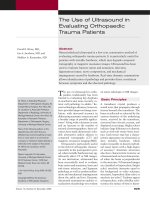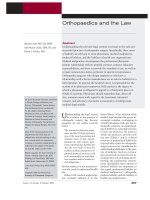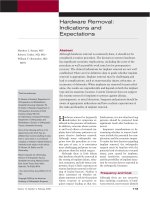Chấn thương chỉnh hình trong bệnh nhân mang thai ppt
Bạn đang xem bản rút gọn của tài liệu. Xem và tải ngay bản đầy đủ của tài liệu tại đây (107.04 KB, 8 trang )
Orthopaedic Trauma in the
Pregnant Patient
Abstract
Trauma affects up to 8% of pregnancies and is the leading cause of
death among pregnant women in the United States. A pregnancy
test is mandated for all females of childbearing age who are in-
volved in trauma. Orthopaedic trauma in the pregnant patient is
managed similarly to that for all trauma patients. Initial resuscita-
tion efforts should focus on the pregnant patient because stable pa-
tient vital signs provide the best chance for fetal survival. In the
stable patient, fetal assessment and a pelvic examination are man-
datory. Radiographs as well as abdominal ultrasound of the patient
and fetal ultrasound are useful. No known biologic risks are associ-
ated with magnetic resonance imaging, and no specific fetal abnor-
malities have been linked with standard low-intensity magnetic
resonance imaging. Emergency surgery can be safely performed in
most pregnant patients. Avoiding patient hypotension and using
left lateral decubitus positioning increase the likelihood of success
for the patient and fetus. An experienced multidisciplinary team
consisting of an obstetrician, perinatologist, orthopaedic surgeon,
anesthesiologist, radiologist, and nursing staff will optimize the
treatment of both the pregnant patient and her fetus.
T
rauma affects as many as 8% of
pregnancies and is the leading
cause of maternal death in the Unit-
ed States.
1-4
Because the fetus is ful-
ly dependent on the physiology of
the pregnant patient, proper patient
resuscitation is the best fetal resus-
citation.
3
Similarly, although both
patient and fetal investigations are
necessary, the initial management of
any severe trauma should focus first
on the pregnant patient. Most cir-
cumstances that may lead to mater-
nal instability (eg, hypotension) also
will be catastrophic for the fetus.
Therefore, treatment algorithms and
priorities according to the Advanced
Trauma Life Support standards are
similar for both the pregnant and the
nonpregnant trauma patient.
5
Fetal
evaluation should not interfere with
assessment of potentially life-
threatening injuries in the pregnant
patient.
Epidemiology
Trauma is the primary cause of
nonobstetric-related death during
pregnancy; as such, it is of great con-
cern to trauma surgeons and gyne-
cologists.
6,7
Motor vehicle accidents
account for a large portion of blunt
trauma during pregnancy and are the
leading cause of death in girls and
women aged 8 through 28 years.
8
Domestic violence, another com-
mon cause of trauma during preg-
nancy, is involved in 10% of cas-
es.
1,9
Approximately 0.3% to 0.4% of
Kyle Flik, MD
Peter Kloen, MD, PhD
Jose B. Toro, MD
William Urmey, MD
Jan G. Nijhuis, MD, PhD
David L. Helfet, MD
Dr. Flik is Attending Orthopaedic
Surgeon, Northeast Orthopaedics, LLP,
Albany, NY. Dr. Kloen is Director,
Orthopaedic Trauma, Academic Medical
Center, Amsterdam, The Netherlands.
Dr. Toro is Orthopaedic Trauma Fellow,
Hospital for Special Surgery, New York,
NY. Dr. Urmey is Assistant Attending
Anesthesiologist, Hospital for Special
Surgery. Dr. Nijhuis is Professor,
Obstetrics, and Head, Division of
Maternal-Fetal-Medicine, Academic
Hospital Maastricht, Maastricht, The
Netherlands. Dr. Helfet is Attending
Orthopaedic Surgeon and Chief,
Orthopaedic Trauma Service, Hospital
for Special Surgery.
None of the following authors or the
departments with which they are
affiliated has received anything of value
from or owns stock in a commercial
company or institution related directly or
indirectly to the subject of this article:
Dr. Flik, Dr. Kloen, Dr. Toro, Dr. Urmey,
Dr. Nijhuis, and Dr. Helfet.
Reprint requests: Dr. Helfet,
Orthopaedic Trauma Service, Hospital
for Special Surgery, 535 East 70th
Street, New York, NY 10021.
J Am Acad Orthop Surg 2006;14:175-
182
Copyright 2006 by the American
Academy of Orthopaedic Surgeons.
Volume 14, Number 3, March 2006 175
traumatized pregnant patients re-
quire hospital admission; as many as
24% of these patients die as a result
of their injuries.
10,11
Maternal trau-
ma is also the leading nonobstetric
cause of fetal death.
3
In addition to
high-energy trauma and domestic vi-
olence, pregnancy-related osteoporo-
sis may be present during the third
trimester and may contribute to
fractures in some women after rela-
tively minor injuries.
12-17
Proper evaluation of trauma in
the pregnant patient requires a clear
understanding of the severity of the
injury and its relation to both the
pregnant patient and the fetus. Inad-
equate management not only will
have adverse consequences for the
patient but also may be disastrous
for the fetus.
Key Physiologic
Changes During
Pregnancy
Numerous changes in the pregnant
female’s anatomy and physiology
must be considered during emergen-
cy orthopaedic care (Table 1). In the
pregnant woman, plasma volume
expands by 40% to 50% by the end
of the first trimester (Table 2). Red
blood cell mass also expands, but
less so than plasma volume, result-
ing in a dilutional anemia and a
corresponding small decrease in he-
matocrit level. This adaptive prepa-
ration for blood loss during child-
birth provides greater tolerance to
blood loss in a trauma situation. The
physician caring for a pregnant pa-
tient with traumatic blood loss must
avoid a false sense of assurance re-
garding the degree of hemorrhage or
hemodynamic instability. Clinically,
blood loss up to 2,000 mL (30%) may
not be readily apparent in the preg-
nant patient because mean arterial
pressure often remains stable. Al-
though shock in the patient may be
obscured by the altered physiology
of pregnancy, a 30% loss in patient
blood may decrease placental flow
by 10% to 20%.
18
In addition, cardi-
ac output increases during pregnan-
cy, peaking 35% to 50% above base-
line at 28 to 32 weeks’ gestation.
8
Another important hemodynam-
ic consideration in the pregnant
trauma patient is the potential hy-
potensive effect of supine position-
ing. This effect, which is caused by
aortocaval compression by the en-
larged uterus, may decrease cardiac
output by 25%. Use of a right hip
wedge, manual displacement of the
Table 1
Important Physiologic Changes During Pregnancy
Parameter Change Implication
Maternal blood
volume
Increased Attenuated initial response to
hemorrhage
Cardiac output Increased Increased metabolic demands
Uterine size Enlarged Potential for supine hypotension
from aortocaval compression
Functional lung
residual volume
Decreased Hypoxemia from atelectasis
Gastrointestinal
motility
Decreased Greater risk for aspiration
Minute ventilation Increased Compensated respiratory alkalosis
Adapted with permission from Van Hook JW: Trauma in pregnancy. Clin Obstet
Gynecol 2002;45:414-424.
Table 2
Physiologic Changes Affecting Diagnosis and Treatment of the Pregnant
Patient With an Orthopaedic Injury
First Trimester
Major organogenesis (radiosensitive)
Central nervous system development (most sensitive period)
Increased risk of teratogenesis
Elevated white blood cell count may be normal
Elevated erythrocyte sedimentation rate may be normal
Hypercoagulable state
Increased risk of spontaneous abortion related to general anesthesia
Second Trimester
Fetal central nervous system relatively radioresistant
Hypotension possible with supine positioning caused by aortocaval
compression (as a result of increased uterus size)
Elevated white blood cell count may be normal
Elevated erythrocyte sedimentation rate may be physiologically normal
Hypercoagulable state
Increased risk of spontaneous abortion related to general anesthesia
Increased risk of seat belt–related injury to the fetus
Third Trimester
Maternal plasma expands by 40% to 50% (dilutional anemia)
Pregnancy-related osteoporosis possible
Increased risk of seat belt–related injury to the fetus
Elevated white blood cell count may be physiologically normal
Elevated erythrocyte sedimentation rate may be physiologically normal
Orthopaedic Trauma in the Pregnant Patient
176 Journal of the American Academy of Orthopaedic Surgeons
uterus, or lateral tilt positioning of
the patient may help avoid this situ-
ation. White blood cell count may be
normally elevated to 18,000/mm
3
during pregnancy. Leukocytosis and
erythrocyte sedimentation rate are
unreliable indicators of infection in
the pregnant patient.
Finally, a hypercoagulable state
exists because of an increase in clot-
ting factors and fibrinogen levels.
This is important to consider in the
postoperative immobilization phas-
es with regard to the crucial need for
prophylaxis for deep vein thrombo-
sis. Therapeutic doses of subcutane-
ous fractionated heparin with se-
quential compression boots should
be routinely used whenever possible.
Warfarin is contraindicated.
Initial Evaluation
Pregnancy alters neither the stan-
dard primary survey of the injured
patient (airway evaluation, breath-
ing, and circulation) nor the usual di-
agnostic pharmacologic or resuscita-
tive procedures and interventions.
5
Placing the patient on a backboard
with a 15° angle to the left is a
pregnancy-specific intervention that
should be used in all patients beyond
the 20-week gestation period. This
precaution partially relieves the
compressive effect of the uterus on
the vena cava, which can reduce ma-
ternal cardiac output up to 30%.
19
A diagnosis of pregnancy should
be made early during patient evalu-
ation. A urine pregnancy test initial-
ly and/or a serum β-hCG (human
chorionic gonadotropin) hormone
test is mandatory in all women of
childbearing age who are involved in
trauma.
20
With the pregnant patient,
gestational age is important for deci-
sions related to further fetal surveil-
lance and patient care. Beyond
gestational week 20, simultaneous
monitoring of fetal heart rate and
uterine activity (cardiotocography)
should begin in the emergency de-
partment, even in the patient with
minor trauma. Hypovolemic shock
may occur with minimal changes in
pulse or blood pressure, and fetal dis-
tress may be the first sign of patient
hemodynamic compromise.
18,21
Patient medical, surgical, and
pregnancy history is important be-
cause of the possibility of preexisting
hypertension, eclampsia, and diabe-
tes. As in all motor vehicle acci-
dents, patient seat belt usage is im-
portant. Restraint during pregnancy
has been shown to contribute to in-
creased survival rates for both pa-
tient and fetus following motor vehi-
cle accidents.
22
Research also
suggests that many pregnant women
(25% to 50%) do not follow estab-
lished guidelines for seat belt use
during pregnancy, indicating a need
for increased educational out-
reach.
22
The primary goal in managing the
pregnant trauma patient should be
evaluating and stabilizing her vital
signs. Adequate oxygenation and
pulse oximeter monitoring are im-
portant because hypoxia is a signifi-
cant factor in fetal distress. The
pregnant patient who appears to be
hemodynamically stable may be si-
lently compensating at the expense
of the fetus. Therefore, an aggressive
approach to resuscitation, diagnosis,
and treatment is essential for these
patients.
2
In general, the condition of
the pregnant patient directly influ-
ences the fate of the fetus.
6,23-25
In the
pregnant patient, a high Injury Se-
verity Score and a low Glasgow
Coma Scale score on admission are
associated with adverse outcomes
for the fetus.
6,26
Other important ini-
tial predictors of fetal mortality in-
clude low hemoglobin level on ad-
mission, longer hospitalizations, and
the development of disseminated in-
travascular coagulation.
6
After ensuring patient stability,
fetal ultrasound provides useful in-
formation regarding fetal well-being.
Fetal motion, bradycardia, tachycar-
dia, and placental integrity may be
rapidly evaluated with ultra-
sound.
21
Radiographic
Evaluation
The estimation by the general public
of the dangers of diagnostic radio-
graphs during pregnancy is exagger-
ated. The maximum recommended
dose by the National Council on Ra-
diation Protection During Pregnancy
is 50 mGy (5 rad).
27
Potential effects
of radiation to the fetus may be
grouped into three categories: terato-
genesis (fetal malformation), carcino-
genesis (induced malignancy), and
mutagenesis (alteration of germ-line
genes). Teratogenesis relates largely
to central nervous system (CNS)
changes, such as microcephaly and
mental retardation. A linear dose-
related association between mental
retardation and radiation exists, but
this association is not statistically
significant at doses generated by di-
agnostic radiography.
27
The dosage
required to double the baseline mu-
tation rate is between 50 and 100 rad,
far in excess of the doses received
during most diagnostic studies.
27
During pregnancy, the radiation-
absorbed dose to the fetus is of great-
er concern than the maternal dose
because the fetus’ cells are rapidly
dividing and thus are more
radiosensitive. Major organogenesis
occurs during weeks 3 through 8;
substantial radiation to the fetus
during this time may cause malfor-
mation. Primarily up to week 15, the
CNS is the most sensitive organ sys-
tem. After week 25, the fetal CNS is
relatively radioresistant.
28
According
to Timins,
28
absorption by the fetus
of <100 mGy (10 rad) does not in-
crease the risk of fetal death, malfor-
mation, or impaired mental develop-
ment. Between weeks 8 and 15,
doses of 200 to 500 mGy (20 to 50
rad) may result in a measurable re-
duction in IQ. Doses >500 mGy (50
rad) are associated with a higher in-
cidence of growth retardation and
CNS damage.
27,28
Most diagnostic radiographs and
nuclear medicine studies result in
fetal radiation doses that are well be-
Kyle Flik, MD, et al
Volume 14, Number 3, March 2006 177
low the threshold of risk (Table 3).
For example, a single radiograph of
the pelvis yields only 0.040 rad.
Nonetheless, all radiographs should
be performed so as to minimize the
amount of exposure to the fetus.
Collimation of the x-ray beam and
shielding the fetus with a lead apron
may help accomplish this goal. A
clear perception of the actual risks
and benefits of radiographic studies
during pregnancy is required to en-
sure proper patient care and coun-
sel.
There are no known biologic risks
associated with magnetic resonance
imaging (MRI), and no specific fetal
abnormalities have been linked with
standard low-intensity MRI scan-
ning. In their study of children aged
9 months who had had an MRI per-
formed in utero, Clements et al
29
re-
ported no abnormalities related to
that MRI.
The primary x-ray survey of any
trauma patient should include a lat-
eral cervical spine, an anteroposteri-
or chest, and an anteroposterior pel-
vic radiograph. Placing a lead shield
over the abdomen whenever possible
provides additional protection for
the fetus. Abdominal ultrasound has
similar efficacy for evaluating ab-
dominal trauma in pregnant and
nonpregnant patients; it should be
used as required by the trauma
team.
30
In general, computed tomography
(CT) is an excellent rapid screening
modality, although radiation doses
are significantly higher than those
from plain radiographs. Spiral CT is
advantageous because it can scan a
large volume in a short time. A CT
scan may show uterine rupture or
placental separation. When a CT
scan is required for further evalua-
tion of a pelvic ring injury or for sur-
gical planning, patients should be
made aware of the slight possibility
of induced carcinogenesis in all stag-
es of pregnancy (0.2% to 0.8% for
pelvic CT delivering a 5-rad dose).
31
The cervical spine and the thorax
may be evaluated with proper (lead)
apron protection, in accordance with
the Advanced Trauma Life Suppor t
protocol. When further evaluation of
the spine is needed, the use of MRI is
warranted and safe. When MRI is
unavailable, selective use of CT
scanning should be used based on
evaluation of the risks of radiation
exposure versus the possible benefit
of the CT scan.
31
Anesthetic and
Perioperative
Medication
Several concerns regarding anes-
thesia are associated with the preg-
nant patient. Brodsky et al
32
and
Steinberg and Santos
33
studied surgi-
cal anesthesia during pregnancy and
fetal outcome; they advocate post-
poning purely elective surgery until
the postpartum period. If possible,
they recommend deferring necessary
surgery until after the first trimester.
However, postponing surgery is not
always feasible in the orthopaedic
trauma patient.
The most critical time for chem-
ical exposure in humans is thought
to be during major organogenesis,
generally between gestation day 15
and day 65.
34
Mazze and Kallen
35
carefully reviewed 5,405 women
who received anesthesia during preg-
nancy and found no increase in con-
genital abnormalities or stillbirths.
They did find an increased incidence
of low-birth-weight infants, howev-
er, because of prematurity and in-
trauterine growth retardation. This
study is corroborated by Duncan et
al,
34
who found no increase in con-
genital anomalies between a group
of 2,565 pregnant women who were
operated on and a matched group of
women who were not operated on.
They did, however, find an increased
risk of spontaneous abortion in the
group that had undergone surgery
with general anesthesia in the first
or second trimester. In a smaller
study, Brodsky et al
32
reported no in-
crease in congenital anomalies in
the infants born to 287 women who
underwent surgery during pregnan-
cy. They did report a slightly higher
rate of spontaneous abortion, how-
ever.
The Collaborative Perinatal
Project showed that the administra-
tion of local anesthetics such as ben-
zocaine, procaine, tetracaine, and
lidocaine during pregnancy did not
result in an increased rate of fetal
malformation.
33
Thus, with the ex-
Table 3
Fetal Radiation Exposure (Approximate) During Common Radiographic
Studies
Radiographic Study Rad
No. of Studies to
Reach Cumulative
5 rad
Cervical spine 0.002 2,500
Chest (two views) 0.00007 71,429
Pelvis 0.040 125
Hip (single view) 0.213 23
CT head (10 slices) <0.050 >100
CT chest (10 slices) <0.100 >50
CT abdomen (10 slices) 2.600 1
CT lumbar spine (5 slices) 3.500 1
Ventilation-perfusion scan 0.215 23
CT = computed tomography
Adapted with permission from Toppenberg KS, Hill DA, Miller DP: Safety of
radiographic imaging during pregnancy. Am Fam Physician 1999;59:1813-1820.
Orthopaedic Trauma in the Pregnant Patient
178 Journal of the American Academy of Orthopaedic Surgeons
ception of cocaine, local anesthetics
administered for clinical use do not
seem to be teratogenic.
Although spinal or epidural anes-
thesia is safe, there is a decreasing
drug requirement for spinal or epidu-
ral anesthesia with advancing gesta-
tion because epidural venous en-
gorgement reduces the volume of
cerebrospinal fluid and the epidural
space.
33
Supplemental sedation, of-
ten required as an adjunct to local
blocks, may be minimized or
avoided with the use of a spinal an-
esthetic.
Maternal hypotension associated
with sympathetic blockade from spi-
nal or epidural anesthesia is a prima-
ry concern because it may cause de-
creased uterine blood flow. As such,
frequent blood pressure measure-
ments should be obtained during the
surgical procedure. At all times, hy-
potension and hypoxia in the preg-
nant patient must be avoided in or-
der to reduce the likelihood of fetal
distress.
When possible, inotropes or pres-
sors should be avoided during the re-
suscitative phase because they cause
a reduction in uteroplacental blood
flow. Volume replacement should be
maximized before their use. Region-
al anesthesia reduces the risk of as-
piration, which is already higher
than in nonpregnant patients be-
cause of decreased gastric motility
during pregnancy. Regional anes-
thesia carries an increased risk of hy-
potension, more often with spinal
than with epidural regional anes-
thesia.
33
Antibiotics should be given at the
same dosing schedule and for the
same indication as for the nonpreg-
nant patient. The safest antibiotics
during pregnancy include the cepha-
losporins and penicillins, or an eryth-
romycin. The administration of pro-
phylactic cefazolin preoperatively
and for 24 hours postoperatively is a
safe procedure in the nonallergic pa-
tient. Antibiotic treatment of open
fracture should follow the guidelines
described by Gustilo and Anderson.
36
Tetanus prophylaxis should be ad-
ministered according to the standard
protocol: 0.5 mL intramuscular tet-
anus toxoid in the fully immunized
patient who has not had a booster
within 5 years; tetanus toxoid plus
passive immunization in the patient
who has not received a full course of
immunization in the past. There is
no known risk for either the pregnant
patient or the fetus.
Pregnancy is considered a hyper-
coagulable state, which, coupled
with prolonged immobilization be-
cause of trauma, places a woman at
increased risk of thrombosis. A pro-
phylactic dose of any of the readily
available commercial fractionated
heparins thus should be adminis-
tered. Warfarin, as well as its chem-
ical subcomponents, crosses the pla-
centa, has teratogenic potential, and
may cause fetal bleeding. Therefore,
its use is not recommended.
37
Un-
fractionated heparin and low-
molecular-weight heparin do not
cross the placenta and are safe for the
fetus. Long-term treatment with un-
fractionated heparin is problematic
because of its inconvenient adminis-
tration, the need to monitor antico-
agulant activity, and its potential
side effects to the patient, such as
heparin-induced thrombocytopenia
and osteoporosis.
37
Low-molecular-
weight heparin is safe in the preven-
tion and treatment of venous throm-
boembolism during pregnancy
because of its ease of administration
and its lower risk of side effects.
37
Because of increased metabolic
and caloric requirements during
pregnancy, early initiation of total
enteral nutrition should be consid-
ered in the patient who is unable to
eat.
Surgical Indications
For the orthopaedic surgeon, safe,
expedient, and appropriate treat-
ment of the patient’s injury is of par-
amount importance. In most in-
stances, emergency surgery may be
safely performed in a pregnant pa-
tient. There are several steps that
the surgeon should take to optimize
the outcome for both patient and fe-
tus.
All orthopaedic emergencies
should be treated as such, regardless
of pregnancy status. Most extremity
fractures are managed in the same
manner that they would be in a non-
pregnant patient. The radiation ex-
posure to a fetus from extremity ra-
diographs is minimal. An obvious
exception is a radiograph of the prox-
imal femur or pelvis, which exposes
the fetus to more radiation than does
an extremity radiograph. Therefore,
it is reasonable, for example, to
choose a surgical technique for fem-
oral fractures that would limit the
amount of radiation needed to satis-
factorily accomplish the goal of fix-
ation (ie, open plating versus in-
tramedullary nailing). Whenever
possible, an injury that would other-
wise lead to a prolonged period of
bed rest should be surgically ad-
dressed to enable early mobilization.
The potential comorbidities associ-
ated with inactivity and bed rest
likely outweigh the risks of surgery.
As mentioned, elective orthopaedic
procedures should be delayed until
the postpartum period.
Pelvic fractures are of special in-
terest in the pregnant patient be-
cause of the proximity of the uterus
and the potential for severe blood
loss. In the later stages of pregnancy ,
there is a possibility of high intra-
abdominal pressure, which increases
the risk of injuries to large vessels,
such as the vena cava and, in partic-
ular, the pelvic veins. Also, as a re-
sult of the increased perfusion to the
uterus and placenta associated with
pregnancy, injury to this area is most
often associated with severe hemor-
rhage. Severe bleeding from abruptio
placentae may occur, which may ne-
cessitate an emergency hysterecto-
my.
24,25,38
Pape et al
39
reported the results of
seven pregnant patients with pelvic
and/or acetabular fractures. The
mean Injury Severity Score was 29.9
Kyle Flik, MD, et al
Volume 14, Number 3, March 2006 179
points. Two pregnant patients and
four fetuses died as a result of these
injuries. For two of three patients
with live fetuses, treatment of the
pelvic fracture was modified because
of the pregnancy.
In the stable pregnant patient re-
quiring surgery, modern ultrasound
techniques may be used to easily
monitor fetal hear t rate during the
operation. When the patient is under
general anesthesia, the fetus also
will be anesthetized, resulting in a
heart rate pattern without any vari-
ability.
40
However, when decreased
blood flow to the uterus leads to fe-
tal hypoxia, the fetal heart rate will
exhibit decelerations. Heart rate de-
celeration should alert the anesthe-
siologist that blood pressure may be
changing or that the patient should
be repositioned.
Patient Positioning
Patient positioning must be deter-
mined with a focus on the well-
being of the fetus. To avoid compres-
sion of the inferior vena cava in the
patient who is in her second or third
trimester, the left lateral decubitus
position (left side down) should be
used during anesthesia. This precau-
tion partially relieves the compres-
sive effect of the gravid uterus on the
vena cava, which can reduce patient
cardiac output up to 30%.
19
Alterations in uteroplacental
blood flow also may be avoided by
maintaining adequate mean arterial
pressure in the patient. Unfortunate-
ly, some fractures (eg, a left calca-
neus fracture needing a lateral ap-
proach) cannot be surgically treated
with the patient in the formal later-
al decubitus position. In these pa-
tients, nonsurgical management
may be the best option. Flexibility is
required in patient positioning be-
cause some degree of lateral decubi-
tus positioning is required in pa-
tients in the late second or third
trimester of pregnancy.
Fracture Fixation
Techniques
The ongoing evolution of surgical
fracture care has resulted in a large
armamentarium of fixation tools
and techniques. Given the risks as-
sociated with radiation exposure,
the orthopaedic surgeon should
choose the fixation technique that
requires the minimum amount of ra-
diation without compromising frac-
ture care.
Especially early in the pregnancy,
when fetal development is most frag-
ile, judicial and minimal use of radi-
ography should be employed. The
benefits and risks of each surgical
technique and the experience of the
surgeon should be carefully weighed.
For instance, whereas the so-called
minimally invasive (percutaneous)
plating techniques are popular, they
are associated with a steep learning
curve, which often results in a high
cumulative radiation exposure time.
This is also true for intramedullary
nailing of a comminuted long bone
fracture that might be difficult to re-
duce before nail insertion. The com-
minution makes obtaining proper
alignment for passage of a guidewire
more difficult, potentially leading to
additional radiation exposure. In
these cases, the surgeon should con-
sider open plating techniques that do
not rely so heavily on radiographic
control. A carefully developed surgi-
cal plan will help decrease surgical
time while also preparing for poten-
tial intraoperative problems.
Both acetabular and pelvic frac-
ture fixation warrant referral to a spe-
cialist. The pelvic or acetabular frac-
ture requiring surgical reduction and
fixation in the pregnant patient pro-
vides a formidable challenge for the
treating surgeon. Only a few cases of
surgical treatment of pelvic or ace-
tabular fractures in association with
pregnancy have been repor ted.
39,41-45
In a recent literature review covering
the years 1932 through 2000, Leggon
et al
4
identified a total of 101 reported
cases of pelvic or acetabular fractures
in pregnant patients. Three mecha-
nisms of injury were identified: mo-
tor vehicle collision (73%), falls
(14%), and pedestrian struck by a car
(13%). Most patients (57%) were in
their third trimester. Both mecha-
nism of injury and injur y severity
were related to mortality rates. How-
ever, fracture designation (simple ver-
sus complex), fracture type (acetabu-
lar versus pelvic), the trimester of
pregnancy, and the era in which the
patient received treatment had no in-
fluence on mortality rates. Hemor-
rhage in the pregnant patient had a
greater association with fetal demise
than did direct trauma to the uterus,
placenta, or fetus. The overall fetal
mortality rate in pelvic and acetabu-
lar fractures was 35% versus a 9%
patient mortality rate.
4
A healed pelvic or acetabular frac-
ture sustained during or before preg-
nancy (whether treated surgically or
nonsurgically) does not represent an
absolute contraindication to vaginal
delivery, provided the pelvic archi-
tecture is not disrupted. With the
pregnant patient, clinical and surgi-
cal decisions must be based on the
nature of the injury, careful assess-
ment of the clinical status of the pa-
tient and fetus, and evaluation of the
risk-benefit ratio of the surgical pro-
cedure and its clinical consequences
for both the patient and the fetus.
Summary
Evaluation and treatment of the preg-
nant patient with an orthopaedic in-
jury present unique challenges to the
orthopaedic surgeon. This scenario is
often unfamiliar. Diagnostic evalua-
tion and clinical decision making
must be carefully considered and ex-
ecuted in a short period. Decisions
must be made regarding the use and
safety of radiographic studies, fetal
monitoring, the timing and indica-
tions for surgical intervention, and
the appropriate use of medications
and anesthesia during and after sur-
gery. An experienced multidisci-
plinary team comprising an obstetri-
Orthopaedic Trauma in the Pregnant Patient
180 Journal of the American Academy of Orthopaedic Surgeons
cian, perinatologist, orthopaedic
surgeon, anesthesiologist, radiologist,
and nursing staff should be involved
in caring for the pregnant trauma pa-
tient with musculoskeletal injuries.
Thorough knowledge of the specific
patient care issues related to the
pregnant patient with an orthopaedic
injury maximizes the chances for op-
timal outcomes for both the patient
and the fetus.
References
Evidence-based Medicine: The au-
thors note that there are no level I or
level II evidence-based studies.
Citation numbers printed in bold
type indicate references published
within the past 5 years.
1. D’Amico CJ: Trauma in pregnancy.
Top Emerg Med 2002;24:26-39.
2. Esposito TJ: Trauma during pregnan-
cy. Emerg Med Clin North Am 1994;
12:167-199.
3. Fildes J, Reed L, Jones N, Martin M,
Barrett J: Trauma: The leading cause
of maternal death. J Trauma 1992;32:
643-645.
4. Leggon RE, Wood GC, Indeck MC:
Pelvic fractures in pregnancy: Factors
influencing maternal and fetal out-
comes. J Trauma 2002;53:796-804.
5. Bell RM, Krantz BE, Weigelt JA: ATLS:
A foundation for trauma training.
Ann Emerg Med 1999;34:233-237.
6. Ali J, Yeo A, Gana TJ, McLellan BA:
Predictors of fetal mortality in preg-
nant trauma patients. J Trauma 1997;
42:782-785.
7. Kissinger DP, Rozycki GS, Morris JA
Jr, et al: Trauma in pregnancy: Predict-
ing pregnancy outcome. Arch Surg
1991;126:1079-1086.
8. Van Hook JW: Trauma in pregnancy.
Clin Obstet Gynecol 2002;45:414-
424.
9. Pepperell RJ, Rubinstein E, MacIsaac
IA: Motor-car accidents during preg-
nancy. Med J Aust 1977;1:203-205.
10. Lavin JP Jr, Polsky SS: Abdominal
trauma during pregnancy. Clin
Perinatol 1983;10:423-438.
11. Rothenberger D, Quattlebaum FW,
Perry JF Jr, Zabel J, Fischer RP: Blunt
maternal trauma: A review of 103 cas-
es. J Trauma 1978;18:173-179.
12. Chung HC, Lim SK, Lee MK, Lee MH,
Huh KB: Pregnancy-associated os-
teoporosis. Yonsei Med J 1988;29:
286-294.
13. Dunne F, Walters B, Marshall T,
Heath DA: Pregnancy associated os-
teoporosis. Clin Endocrinol (Oxf)
1993;39:487-490.
14. Khovidhunkit W, Epstein S: Os-
teoporosis in pregnancy. Osteoporos
Int 1996;6:345-354.
15. Phillips AJ, Ostlere SJ, Smith R:
Pregnancy-associated osteoporosis:
Does the skeleton recover?
Osteoporos Int 2000;11:449-454.
16. Smith R, Phillips AJ: Osteoporosis
during pregnancy and its manage-
ment. Scand J Rheumatol Suppl
1998;107:66-67.
17. Wattanawong T, Wajanavisit W, Lao-
hacharoensombat W: Transient os-
teoporosis with bilateral fracture of
the neck of the femur during pregnan-
cy: A case report. J Med Assoc Thai
2001;84(suppl 2):S516-S519.
18. Barron WM: The pregnant surgical pa-
tient: Medical evaluation and man-
agement. Ann Intern Med 1984;101:
683-691.
19. Shah AJ, Kilcline BA: Trauma in preg-
nancy. Emerg Med Clin North Am
2003;21:615-629.
20. Crosby WM, Haycock CE, Karkal SS:
An emergency care protocol for trau-
ma in pregnancy. Emerg Med Rep
2004;8:73.
21. Goldman SM, Wagner LK: Radiologic
ABCs of maternal and fetal survival
after trauma: When minutes may
count. Radiographics 1999;19:1349-
1357.
22. McGwin G Jr, Russell SR, Rux RL,
Leath CA III, Valent F, Rue LW III:
Knowledge, beliefs, and practices con-
cerning seat belt use during pregnan-
cy. J Trauma 2004;56:670-675.
23. Aitokallio-Tallberg A, Halmesmäki
E: Motor vehicle accident during the
second or third trimester of pregnan-
cy. Acta Obstet Gynecol Scand
1997;76:313-317.
24. Towery R, English TP, Wisner D:
Evaluation of pregnant women after
blunt injur y. J Trauma 1993;35:731-
735.
25. Vaizey CJ, Jacobson MJ, Cross FW:
Trauma in pregnancy. Br J Surg 1994;
81:1406-1415.
26. George ER, Vanderkwaak T, Scholten
DJ: Factors influencing pregnancy
outcome after trauma. Am Surg
1992;58:594-598.
27. Toppenberg KS, Hill DA, Miller DP:
Safety of radiographic imaging during
pregnancy. Am Fam Physician 1999;
59:1813-1820.
28. Timins JK: Radiation during pregnan-
cy. N J Med 2001;98:29-33.
29. Clements H, Duncan KR, Fielding K,
Gowland PA, Johnson IR, Baker PN:
Infants exposed to MRI in utero have
a normal paediatric assessment at 9
months of age. Br J Radiol 2000;73:
190-194.
30. Goodwin H, Holmes JF, Wisner DH:
Abdominal ultrasound examination
in pregnant blunt trauma patients.
J Trauma 2001;50:689-693.
31. Committee on the Biological Effects
of Ionizing Radiations: The Effects on
Populations of Exposure to Low Lev-
els of Ionizing Radiation. Washing-
ton, DC: National Academy Press,
1980.
32. Brodsky JB, Cohen EN, Brown BW,
Wu ML, Whitcher C: Surgery during
pregnancy and fetal outcome. Am J
Obstet Gynecol 1980;138:1165-1167.
33. Steinberg ES, Santos AC: Surgical
anesthesia during pregnancy. Int
Anesthesiol Clin 1990;28:58-66.
34. Duncan PG, Pope WD, Cohen MM,
Greer N: Fetal risk of anesthesia
and surgery during pregnancy.
Anesthesiology 1986;64:790-794.
35. Mazze RI, Kallen B:Reproductive out-
come after anesthesia and operation
during pregnancy: A registr y study of
5405 cases. Am J Obstet Gynecol
1989;161:1178-1185.
36. Gustilo RB, Anderson JT: Prevention
of infection in the treatment of one
thousand and twenty-five open frac-
tures of long bones:Retrospective and
prospective analyses. J Bone Joint
Surg Am 1976;58:453-458.
37. Ageno W, Crotti S, Turpie AG: The
safety of antithrombotic therapy dur-
ing pregnancy. Expert Opin Drug Saf
2004;3:113-118.
38. Rose PG, Strohm PL, Zuspan FP: Feto-
maternal hemorrhage following trau-
ma. Am J Obstet Gynecol 1985;153:
844-847.
39. Pape HC, Pohlemann T, Gänsslen A,
Simon R, Koch C, Tscherne H: Pelvic
fractures in pregnant multiple trauma
patients. J Orthop Trauma 2000;14:
238-244.
40. van Buul BJ, Nijhuis JG, Slappendel R,
Lerou JG, Bakker-Niezen SH: General
anesthesia for surgical repair of intra-
cranial aneurysm in pregnancy: Ef-
fects on fetal heart rate. Am J
Perinatol 1993;10:183-186.
41. Dunlop DJ, McCahill JP, Blakemore
ME: Internal fixation of an acetabular
fracture during pregnancy. Injury
1997;28:481-482.
42. Pals SD, Brown CW, Friermood TG:
Open reduction and internal fixation
of an acetabular fracture during preg-
nancy. J Orthop Trauma 1992;6:379-
381.
Kyle Flik, MD, et al
Volume 14, Number 3, March 2006 181
43. Yosipovitch Z, Goldberg I, Ventura E,
Neri A: Open reduction of acetabular
fracture in pregnancy: A case report.
Clin Orthop Relat Res 1992;282:229-
232.
44. Kloen P, Flik K, Helfet DL: Operative
treatment of acetabular fracture dur-
ing pregnancy: A case report. Arch
Orthop Trauma Surg 2005;125:209-
212.
45. Loegters T, Briem D, Gatzka C, et al:
Treatment of unstable fractures of the
pelvic ring in pregnancy. Arch
Orthop Trauma Surg 2005;125:204-
208.
Orthopaedic Trauma in the Pregnant Patient
182 Journal of the American Academy of Orthopaedic Surgeons









